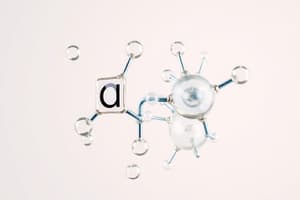Podcast
Questions and Answers
What is the definition of an element?
What is the definition of an element?
- A basic unit of matter consisting of protons and neutrons.
- A substance formed from two or more elements chemically combined.
- A substance that has mass but does not occupy space.
- A pure substance made of only one type of atom. (correct)
What type of bond is formed through the sharing of electrons?
What type of bond is formed through the sharing of electrons?
- Hydrogen bond
- Ionic bond
- Metallic bond
- Covalent bond (correct)
Which of the following best describes a gas?
Which of the following best describes a gas?
- Has no definite shape or volume. (correct)
- Has a definite volume but no definite shape.
- Has a definite shape and volume.
- Particles are tightly packed and cannot move.
What do reactants do in a chemical reaction?
What do reactants do in a chemical reaction?
What is the molar mass of a substance?
What is the molar mass of a substance?
What characteristic distinguishes acids from bases?
What characteristic distinguishes acids from bases?
Which type of reaction absorbs heat from its surroundings?
Which type of reaction absorbs heat from its surroundings?
How is the concentration of a solution expressed?
How is the concentration of a solution expressed?
Study Notes
Basic Concepts
- Matter: Anything that has mass and occupies space.
- Atoms: Basic units of matter, consisting of protons, neutrons, and electrons.
- Elements: Pure substances made of only one type of atom; represented on the periodic table.
- Compounds: Substances formed from two or more elements chemically combined in fixed ratios.
Chemical Bonding
- Ionic Bonds: Formed when electrons are transferred from one atom to another, creating charged ions.
- Covalent Bonds: Formed when atoms share electrons.
- Metallic Bonds: Attraction between metal atoms and delocalized electrons, allowing for conductivity.
States of Matter
- Solid: Definite shape and volume; particles are tightly packed.
- Liquid: Definite volume but no definite shape; particles are close but can move past one another.
- Gas: No definite shape or volume; particles are far apart and move freely.
Chemical Reactions
- Reactants: Substances that undergo chemical changes.
- Products: Substances formed as a result of a chemical reaction.
- Types of Reactions:
- Synthesis: Two or more substances combine to form a new compound.
- Decomposition: A single compound breaks down into simpler products.
- Single Replacement: One element replaces another in a compound.
- Double Replacement: Exchange of ions between two compounds.
The Mole and Stoichiometry
- Mole: A unit that measures the amount of substance (6.022 x 10²³ entities).
- Molar Mass: The mass of one mole of a substance, typically in g/mol.
- Stoichiometry: The calculation of reactants and products in chemical reactions based on balanced equations.
Acids and Bases
- Acids: Substances that donate protons (H⁺) in solutions; characterized by a sour taste.
- Bases: Substances that accept protons; characterized by a bitter taste and slippery feel.
- pH Scale: Measures the acidity or basicity of a solution (0-14 scale: <7 = acid, 7 = neutral, >7 = base).
Thermochemistry
- Exothermic Reactions: Release heat to the surroundings (e.g., combustion).
- Endothermic Reactions: Absorb heat from the surroundings (e.g., photosynthesis).
Solutions and Concentrations
- Solution: A homogeneous mixture of solute and solvent.
- Concentration: Amount of solute in a given volume of solution, often expressed in molarity (M = moles of solute/L of solution).
Periodic Table Trends
- Atomic Radius: Increases down a group, decreases across a period.
- Electronegativity: Tendency of an atom to attract electrons; increases across a period, decreases down a group.
- Ionization Energy: Energy required to remove an electron from an atom; increases across a period, decreases down a group.
Laboratory Techniques
- Titration: Technique to determine concentration of a solution by reacting it with a standard solution.
- Filtration: Separation technique to remove solids from liquids.
- Distillation: Process of separating mixtures based on boiling points.
Matter and its Composition
- Matter: Anything that has mass and takes up space.
- Atoms: The basic building blocks of matter, consisting of protons, neutrons, and electrons.
- Elements: Pure substances composed of only one type of atom. Represented on the periodic table.
- Compounds: Substances formed when two or more elements chemically combine in fixed ratios.
Chemical Bonding
- Ionic Bonds: Formed when electrons are transferred from one atom to another, creating positively and negatively charged ions that attract each other.
- Covalent Bonds: Formed when atoms share electrons to achieve a stable electron configuration.
- Metallic Bonds: Result from the attraction between metal atoms and delocalized electrons, allowing for high conductivity.
States of Matter
- Solid: Definite shape and volume, with tightly packed particles that vibrate in fixed positions.
- Liquid: Definite volume but no definite shape, with particles close together but able to move past one another.
- Gas: No definite shape or volume, with particles widely spaced and moving freely.
Chemical Reactions
- Reactants: Substances that undergo chemical changes during a reaction.
- Products: Substances formed as a result of a chemical reaction.
- Types of Reactions:
- Synthesis: Two or more substances combine to form a new compound (A + B → AB).
- Decomposition: A single compound breaks down into simpler products (AB → A + B).
- Single Replacement: One element replaces another in a compound (A + BC → AC + B).
- Double Replacement: Exchange of ions between two compounds (AB + CD → AD + CB).
The Mole and Stoichiometry
- Mole: A unit of measurement for the amount of substance, representing 6.022 x 10²³ entities.
- Molar Mass: The mass of one mole of a substance, typically expressed in grams per mole (g/mol).
- Stoichiometry: The study of quantitative relationships between reactants and products in chemical reactions, allowing for the calculation of amounts involved in a reaction based on balanced chemical equations.
Acids and Bases
- Acids: Substances that can donate protons (H⁺) in solutions, often characterized by a sour taste.
- Bases: Substances that can accept protons, typically characterized by a bitter taste and slippery feel.
- pH Scale: A measure of acidity or basicity, ranging from 0 to 14, with 7 representing neutral.
Thermochemistry
- Exothermic Reactions: Release heat to the surroundings, resulting in a decrease in the system's temperature.
- Endothermic Reactions: Absorb heat from the surroundings, resulting in an increase in the system's temperature.
Solutions and Concentrations
- Solution: A homogeneous mixture of solute and solvent.
- Concentration: The amount of solute in a given volume of solution, often expressed as molarity (M = moles of solute/liter of solution).
Periodic Table Trends
- Atomic Radius: Tends to increase down a group and decrease across a period on the periodic table.
- Electronegativity: The tendency of an atom to attract electrons in a chemical bond. Increases across a period and decreases down a group.
- Ionization Energy: The energy required to remove an electron from an atom in its gaseous state. Increases across a period and decreases down a group.
Laboratory Techniques
- Titration: A technique used to determine the concentration of a solution by reacting it with a standard solution of known concentration.
- Filtration: A separation technique used to separate solid particles from a liquid mixture.
- Distillation: A process used to separate liquids with different boiling points.
Studying That Suits You
Use AI to generate personalized quizzes and flashcards to suit your learning preferences.
Description
Explore the foundational concepts of chemistry, including matter, atoms, elements, and compounds. Delve into chemical bonding, states of matter, and the principles behind chemical reactions. This quiz will challenge your understanding of these essential topics in chemistry.




